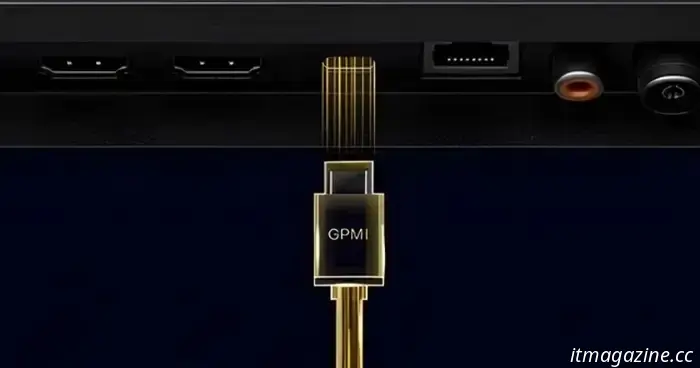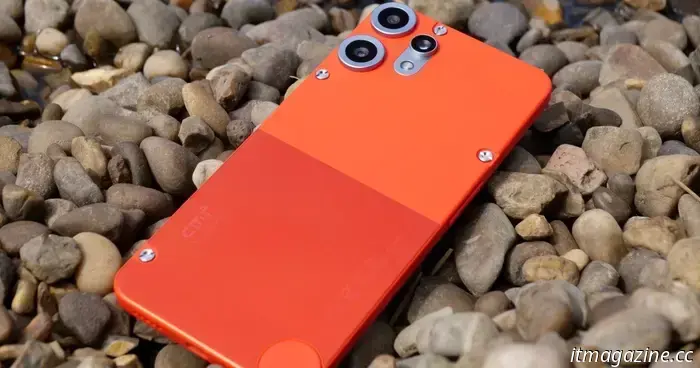
GPMI is significantly superior to HDMI, yet it might never be able to compete.
HDMI has been the primary connector for living rooms for many years, linking TVs to consoles, Blu-ray players, and A/V systems. It's also a good alternative connector for gamers using PCs who prefer not to use DisplayPort. Despite its improvements over the years, HDMI has not kept pace with some emerging competitors, particularly from China.
A new connector, GPMI, has recently been introduced, which, along with USB-C compatibility, boasts options to more than double the bandwidth of HDMI 2.2, and offers power delivery capabilities significantly beyond other existing technologies, including USB4.
Although this new Chinese standard has the potential to challenge HDMI's dominance, it is unlikely to be competitive in Western markets anytime soon.
What is GPMI?
GPMI, or General Purpose Media Interface, is a newly announced connector and cable that made waves in early April. Created by the Shenzhen International 8K Ultra High Definition Video Industry Collaboration Alliance (SUCA), which includes major Chinese brands such as TCL, Hisense, and Huawei, this initiative aims to develop new, competitive standards in light of the diminishing involvement of Chinese brands in global tech infrastructure like 5G.
GPMI comes in two primary versions: GPMI Type-C and GPMI Type-B. The Type-C is a universally designed connector with full USB-C compatibility. Devices with USB-C should work smoothly with GPMI Type-C.
While Type-C offers a commendable data transfer rate of up to 96 Gbps (similar to HDMI 2.2) and 240W power delivery—aligned with the best USB4 connectors—Type-B is the more impressive version. Though it lacks USB-C compatibility, it compensates with its capabilities, positioning itself to potentially surpass HDMI in the future.
GPMI Type-B can achieve a total bandwidth capability of up to 192 Gbps, which is double what HDMI 2.2 can deliver, significantly surpassing DisplayPort 2.1 and the top USB4/Thunderbolt 5 specifications.
While GPMI Type-B is not yet widely available, its specifications indicate notable advantages that could pose a challenge to HDMI and other alternatives.
Both Type-B and Type-C were designed to incorporate several essential features within a single cable, addressing many of the current shortcomings of HDMI and its alternatives:
- Two-way, multi-stream data
- Bidirectional control
- Power delivery
- Compatibility with the USB ecosystem
- Ultra-fast transmission
- Quick wake-up
- Full-chain security
If GPMI can realize these features as it becomes more accessible in the future, it could emerge as a formidable competitor in the A/V and computing domains.
GPMI vs HDMI
In terms of specifications, GPMI clearly outperforms HDMI. Its Type-B bandwidth of up to 192 Gbps far exceeds HDMI 2.1’s 48 Gbps and HDMI 2.2’s 96 Gbps. The Type-C connector presents closer competition, but its USB-C compatibility gives GPMI an edge, particularly since HDMI offers no options for power delivery.
Where can HDMI hold its ground? Features, widespread usage, and brand recognition. While superior specs are beneficial, they must translate into real-world applications.
HDMI includes numerous features integral to the modern entertainment experience. It supports all key HDMI standards, high refresh rates, display stream compression (DSC), chroma subsampling, variable refresh rates, auto low latency mode for gaming, quick frame transport, and quick media switching, all designed to minimize transition times during media playback. Additionally, HDMI 2.1a introduced source-based tone mapping, with HDMI 2.2 expected to enhance audio and video synchronization through a new latency indication protocol.
HDMI is ubiquitous, found across all modern TVs, utilized by major gaming consoles, present in most laptops, and included in every PC graphics card alongside DisplayPort and USB-C options. Its cables are backward compatible and have been in use for over two decades.
Replacing HDMI entails more than merely surpassing it in specifications.
Why specs aren’t enough
GPMI appears to have great potential as a powerful connector, provided it secures adequate support. Brands like Huawei, Hisense, and TCL are developing it, and may include these connectors in future products. However, these companies, while dominant in China, cannot compete with the widespread presence of HDMI in devices from Samsung, Sony, and LG, which all continue to use HDMI.
Moreover, there currently are no compatible devices. For instance, if LG integrates a GPMI port in its TVs in 2026, consumers would struggle to find usable devices. It would likely serve as a USB-C alternative, but awareness of its capabilities may be low. There are no gaming consoles or Blu-ray players available that can utilize it, nor any A/V systems supporting it.
Even in an optimistic scenario where GPMI-compatible TVs and devices are available alongside retail cables in Western



Other articles
 Filming for Avengers: Doomsday has commenced as the Russo Brothers share a teaser image of Doctor Doom.
To celebrate the commencement of filming on Avengers: Doomsday, the Russo Brothers shared a set photo of Robert Downey Jr. as Victor Von Doom.
Filming for Avengers: Doomsday has commenced as the Russo Brothers share a teaser image of Doctor Doom.
To celebrate the commencement of filming on Avengers: Doomsday, the Russo Brothers shared a set photo of Robert Downey Jr. as Victor Von Doom.
 Skin Deep review: quirky immersive simulator that could have benefited from additional chaos.
Skin Deep has aspirations that exceed its capabilities, yet this micro immersive sim still offers enough slapstick chaos to provide its comedic excitement.
Skin Deep review: quirky immersive simulator that could have benefited from additional chaos.
Skin Deep has aspirations that exceed its capabilities, yet this micro immersive sim still offers enough slapstick chaos to provide its comedic excitement.
 Answers for the NYT Mini Crossword on Monday, April 28.
The NYT Mini crossword may be significantly smaller than a standard crossword, but it's still quite challenging. If you're having trouble with today's puzzle, we have the solutions for you.
Answers for the NYT Mini Crossword on Monday, April 28.
The NYT Mini crossword may be significantly smaller than a standard crossword, but it's still quite challenging. If you're having trouble with today's puzzle, we have the solutions for you.
 The remarkable CMF Phone 2 Pro is the smartphone revolutionary we require.
I've gotten hold of Nothing's CMF Phone 2 Pro, and it defies the typical standards of smartphones.
The remarkable CMF Phone 2 Pro is the smartphone revolutionary we require.
I've gotten hold of Nothing's CMF Phone 2 Pro, and it defies the typical standards of smartphones.
 The CEO of OpenAI acknowledges that ChatGPT’s personality can be perceived as ‘too annoying.’
OpenAI has observed that ChatGPT has become overly enthusiastic, and a solution is in progress.
The CEO of OpenAI acknowledges that ChatGPT’s personality can be perceived as ‘too annoying.’
OpenAI has observed that ChatGPT has become overly enthusiastic, and a solution is in progress.
 The certification listing for the Sony Xperia VII exposes new information, highlighting the comeback of a favored color.
Sony's upcoming flagship smartphone, anticipated to be named the Xperia VII, has been listed on the NCC, disclosing several important details.
The certification listing for the Sony Xperia VII exposes new information, highlighting the comeback of a favored color.
Sony's upcoming flagship smartphone, anticipated to be named the Xperia VII, has been listed on the NCC, disclosing several important details.
GPMI is significantly superior to HDMI, yet it might never be able to compete.
For decades, HDMI has been the preferred connector for living rooms. It links TVs to consoles, Blu-ray players, and A/V systems, and serves as an excellent alternative for gaming PC users who prefer not to use DisplayPort. However, despite the advancements in HDMI, it has also lagged behind some [...]
